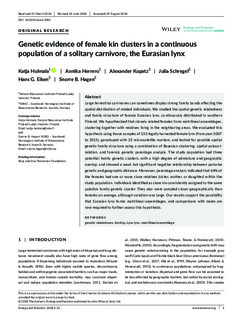Genetic evidence of female kin clusters in a continuous population of a solitary carnivore, the Eurasian lynx
| dc.contributor.author | Holmala, Katja | |
| dc.contributor.author | Herrero, Annika | |
| dc.contributor.author | Kopatz, Alexander | |
| dc.contributor.author | Schregel, Julia | |
| dc.contributor.author | Eiken, Hans Geir | |
| dc.contributor.author | Hagen, Snorre | |
| dc.date.accessioned | 2018-11-14T12:08:18Z | |
| dc.date.available | 2018-11-14T12:08:18Z | |
| dc.date.created | 2018-11-02T10:03:43Z | |
| dc.date.issued | 2018 | |
| dc.identifier.citation | Ecology and Evolution. 2018, . | nb_NO |
| dc.identifier.issn | 2045-7758 | |
| dc.identifier.uri | http://hdl.handle.net/11250/2572822 | |
| dc.description.abstract | Large terrestrial carnivores can sometimes display strong family bonds affecting the spatial distribution of related individuals. We studied the spatial genetic relatedness and family structure of female Eurasian lynx, continuously distributed in southern Finland. We hypothesized that closely related females form matrilineal assemblages, clustering together with relatives living in the neighboring areas. We evaluated this hypothesis using tissue samples of 133 legally harvested female lynx (from year 2007 to 2015), genotyped with 23 microsatellite markers, and tested for possible spatial genetic family structure using a combination of Bayesian clustering, spatial autocor ‐ relation, and forensic genetic parentage analysis. The study population had three potential family genetic clusters, with a high degree of admixture and geographic overlap, and showed a weak but significant negative relationship between pairwise genetic and geographic distance. Moreover, parentage analysis indicated that 64% of the females had one or more close relatives (sister, mother, or daughter) within the study population. Individuals identified as close kin consistently assigned to the same putative family genetic cluster. They also were sampled closer geographically than females on average, although variation was large. Our results support the possibility that Eurasian lynx forms matrilineal assemblages, and comparisons with males are now required to further assess this hypothesis. | nb_NO |
| dc.language.iso | eng | nb_NO |
| dc.rights | Navngivelse 4.0 Internasjonal | * |
| dc.rights.uri | http://creativecommons.org/licenses/by/4.0/deed.no | * |
| dc.title | Genetic evidence of female kin clusters in a continuous population of a solitary carnivore, the Eurasian lynx | nb_NO |
| dc.type | Journal article | nb_NO |
| dc.type | Peer reviewed | nb_NO |
| dc.description.version | publishedVersion | nb_NO |
| dc.rights.holder | © 2018 The Authors. Ecology and Evolution published by John Wiley & Sons Ltd. | nb_NO |
| dc.source.pagenumber | 12 | nb_NO |
| dc.source.journal | Ecology and Evolution | nb_NO |
| dc.identifier.doi | 10.1002/ece3.4562 | |
| dc.identifier.cristin | 1626295 | |
| cristin.ispublished | true | |
| cristin.fulltext | original | |
| cristin.qualitycode | 1 |
Tilhørende fil(er)
Denne innførselen finnes i følgende samling(er)
-
Divisjon for bioteknologi og plantehelse [532]
Publikasjoner knyttet til ansatte ved Divisjon for bioteknologi og plantehelse -
Divisjon for miljø og naturressurser [756]
Publikasjoner knyttet til ansatte ved Divisjon for miljø og naturressurser -
Publikasjoner fra CRIStin - NIBIO [4575]
-
Vitenskapelige artikler [1416]

